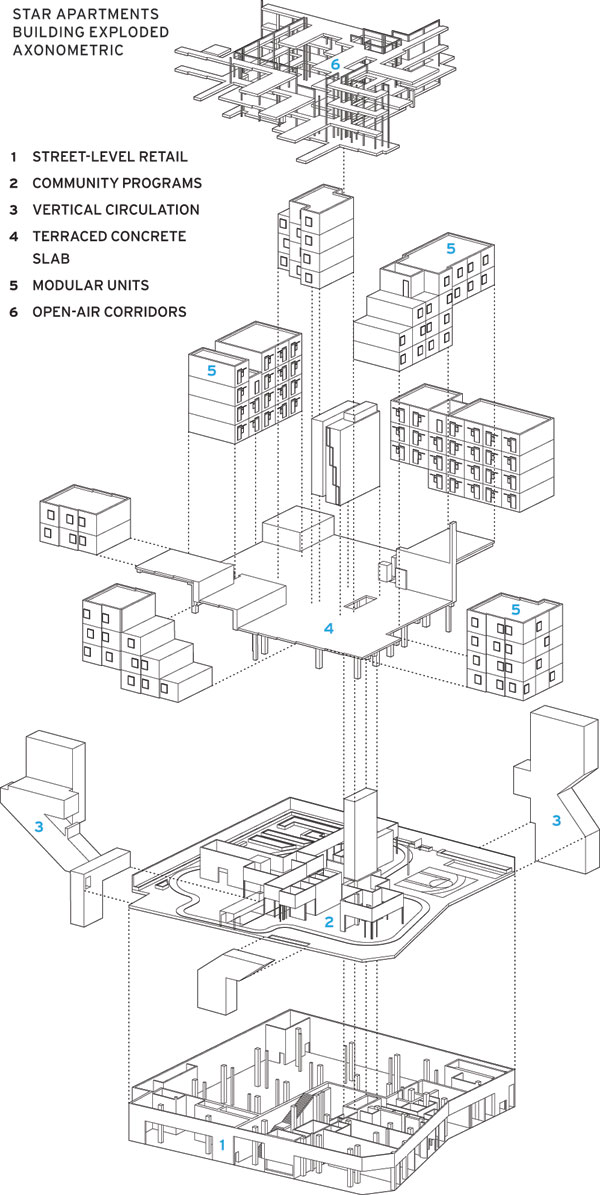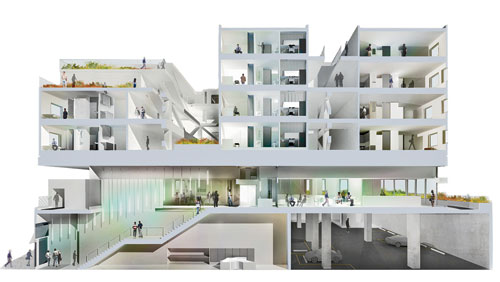Paradigm Shift
After transporting the modules to the site and stacking them by crane, workers will connect the ceiling of one B2 module to another from the outside, creating a structural diaphragm that is tied to a steel-brace frame. The frame, which serves as the building's primary lateral-load-resisting system, will be erected on site, with erection advancing a few levels ahead of module stacking.
One important advantage of using modular construction methods to build B2 would be a reduction in weight, says the team. According to Arup's estimates, the superstructure would be about 40 percent lighter than that of a concrete flat-slab building. The reduction translates into the need for a less hefty foundation system, a particular boon at the Atlantic Yards site, which straddles a busy transportation hub. “Every pile costs much more than it would on a greenfield site,” says Farnsworth.
Multistory modular construction does pose special challenges. For instance, the depth of the floor-and-ceiling sandwich tends to be greater than with common site-built construction methods, since each module has its own, structurally stable lid and base. At Star, for example, the dimension from the underside of the ceiling to the top of the floor is just over 26 inches, compared with a depth of about 14 to 16 inches for a similar wood-framed building in the same fire-resistance class. The extra inches can prove problematic, especially when dealing with building-height restrictions set by zoning laws.
  |
The dwelling units at the Star Apartments stack up to four stories above a stepped podium (top and above). This base incorporates an existing building that has been retrofitted to accommodate a varied program, including retail and recreation space, parking, and social services. Images courtesy Michael Maltzan Architecture |
Resolving modular construction's complex architectural and engineering puzzles, like trying to maximize the number of stories while minimizing overall height, requires intense collaboration among project-team members, close attention to tolerances, and careful orchestration of fabrication and construction sequences, especially since every decision is multiplied hundreds, if not thousands, of times. “There can't be a screw that hasn't been thought through,” says Williams.
To facilitate the necessary coordination, the teams for both the modular B2 and the Star Apartments have relied heavily on BIM for tasks like identifying potential conflicts among the modules' many small components, construction scheduling, estimating the quantity of specific materials, and creating cost estimates.
For the Brooklyn project, the architect, engineer, and others are working with a cloud-based “federated” model–one that allows consultants to input and share discipline-specific models. With the architect's affiliate, SHoP Construction, serving as virtual design and construction coordinator, the team is modeling B2's subassemblies, inserting those into a module, grouping the modules into apartments and floors, and then placing those in the building. The model should help contractors and subcontractors avoid duplicating work, since it can be used to generate documents like a bill of materials, shop drawings, and fabrication tickets. “The project is not so much about product innovation,” says Mallie, “as it is about supply-chain integration.”
Whether the new design and construction paradigm proposed by the modular B2 and the Star Apartments projects will become commonplace remains to be seen. But Forest City Ratner, at least, seems to be envisioning demand well beyond New York for the modules it hopes to build in Brooklyn. “We could even ship the modules overseas,” says Sanna. His comments suggest that modular construction could be more than just an efficient way to build. It might be the key to the revival of a moribund manufacturing sector.








